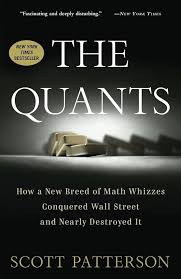Overview : The Quants by Scott Patterson
-
Book Title: The Quants by Scott Patterson
-
Author: Scott Patterson
-
Publication Date: 2 February 2010
-
price: $11.26
-
Pages: 352
Overview of the Book
Scott Patterson is a seasoned financial journalist known for his deep insights into Wall Street and quantitative finance. His book, The Quants, explores the rise of math-driven traders who transformed the financial markets.
Introduction
In the ever-evolving world of finance, few books have captured the essence of modern Wall Street as vividly as Scott Patterson's "The Quants: How a New Breed of Math Whizzes Conquered Wall Street and Nearly Destroyed It." This riveting narrative takes readers on a journey through the complex and high-stakes realm of quantitative finance, exploring how mathematical geniuses revolutionized investing and nearly brought the global economy to its knees.
Book Summary
Patterson's work is a meticulously researched account that traces the origins and rise of quantitative finance. The book introduces key figures in the quant world, such as Ed Thorp, a mathematics professor turned hedge fund manager, who pioneered the application of quantitative methods to finance. Through vivid storytelling, Patterson illustrates how these math prodigies leveraged advanced algorithms and cutting-edge technology to transform Wall Street. The narrative spans from the 1980s through the 2008 financial crisis, detailing how quants created sophisticated trading models that could process vast amounts of data at unprecedented speeds. This technological edge allowed them to identify and exploit market inefficiencies, leading to astronomical profits and, ultimately, contributing to systemic risks that threatened the entire financial system.
Analysis of Themes
The Rise of Quantitative Investing
Patterson expertly dissects the factors that led to the ascendancy of quants in finance. He explores how advancements in computing power, coupled with financial deregulation, created the perfect environment for mathematical models to flourish. The book delves into the development of various quantitative strategies, from statistical arbitrage to high-frequency trading, providing readers with a comprehensive understanding of these complex concepts.
The Human Element in Algorithmic Trading
Despite the focus on mathematical models, "The Quants" never loses sight of the human stories behind the algorithms. Patterson paints vivid portraits of the personalities driving this revolution, highlighting their competitive nature, intellectual curiosity, and sometimes reckless ambition. This humanizing approach makes the book accessible and engaging, even for readers without a background in finance or mathematics.
The Double-Edged Sword of Financial Innovation
One of the book's central themes is the paradoxical nature of financial innovation. While quantitative methods brought unprecedented efficiency and profitability to markets, they also introduced new risks. Patterson skillfully connects the dots between the rise of quant trading and the 2008 financial crisis, arguing that the very models that brought immense wealth to Wall Street also sowed the seeds of its near-destruction.
Writing Style
Patterson's writing style is both informative and engaging, striking a balance between technical explanations and narrative flair. He has a talent for making complex financial concepts accessible to a general audience without oversimplifying. The book's pacing is excellent, with Patterson alternating between character-driven anecdotes and broader analysis of market trends.
Strengths and Weaknesses
Strengths:
- Comprehensive coverage of quantitative finance's evolution
- Engaging portraits of key figures in the quant world
- Clear explanations of complex financial concepts
- Balanced perspective on the impact of quantitative methods
Weaknesses:
- Some readers may find certain technical sections challenging
- The focus on US markets may limit global perspective
Comparison to Other Works
"The Quants" stands out in the crowded field of financial literature for its unique focus on the mathematicians behind modern trading strategies. While Michael Lewis's "The Big Short" offers a compelling narrative of the 2008 financial crisis, Patterson's work provides a deeper exploration of the quantitative methods that underpinned many of the crisis's root causes. Similarly, Nassim Nicholas Taleb's "The Black Swan" discusses the impact of unpredictable events on financial markets, but "The Quants" offers a more focused examination of how mathematical models can both mitigate and exacerbate such risks.
Key Quotes
"The quants' models were supposed to be smarter than the average human. But it turned out they were just as susceptible to panic and greed as anyone else." "In the end, the quants discovered that there are limits to the power of mathematics in predicting the behavior of complex systems like financial markets."
Highlights from The Quants by Scott Patterson
- Rise of quants: Chronicles the emergence of quantitative analysts in finance.
- Mathematical models: Highlights how complex algorithms drive financial markets.
- High-frequency trading: Examines the impact of rapid, automated trading on markets.
- Risk and instability: Explores how quants unintentionally contributed to financial crises.
- Human vs. machine: Discusses the tension between human intuition and algorithm-driven decisions.
- Ethics of quant finance: Questions the morality of quantitative trading and its consequences on market fairness.
Conclusion
"The Quants" is a captivating exploration of how mathematical genius reshaped the landscape of finance. Patterson's work serves as both a celebration of human ingenuity and a cautionary tale about the limits of quantitative models. As financial markets continue to evolve, with the rise of cryptocurrencies and algorithmic trading becoming increasingly prevalent, the lessons from this book remain ever relevant. For investors and finance professionals, "The Quants" offers valuable insights into the mechanisms driving modern markets. It underscores the importance of understanding both the power and limitations of quantitative methods in personal finance and investing strategies. As we navigate an increasingly complex financial world, Patterson's work reminds us of the critical role human judgment plays in interpreting and applying mathematical models.
Where to Buy
Ready to dive into the fascinating world of quantitative finance? Get your copy of "The Quants" by Scott Patterson today: Amazon Barnes & Noble By purchasing through these affiliate links, you'll not only get a great read but also support our efforts to bring you more insightful book reviews on finance and investing.





